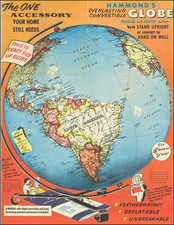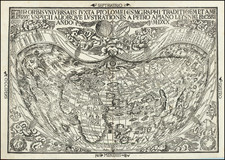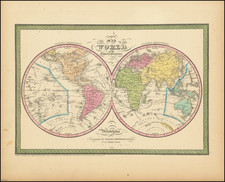This is an interesting map of the ancient world showing the spread of Noah's descendants. Known in biblical scholarship as the Generations of Noah, the sons of Noah were supposed to have spread out to different corners of the world to repopulate the earth. The three direct sons of Noah each spread out in a different direction, where they then divided the land between their respective sons and grandsons. Many of these give rise to the biblical regions as they are now known, and are shown on this map.
As early as the 18th century, this idea of the Generations of Noah would lend itself to racist ideologies, with scholars attempting to split the world between Caucasoids, Negroids, and Mongoloids. Prior to this interpretation, the Generations of Noah had been invoked by many early Christian societies. As the original Jewish texts had no references to northern Europe, Christians in these areas looked to lost sons of Noah or loose readings of the text to explain how their lands came to be populated. This general concept remained surprisingly prevalent into the 19th century.
The map contains an interesting inset of the Bering Strait, invoking the concept of a land bridge to explain the populations in the Americas. The map shows Alaska, Kamchatka, and the "Alkoulskie"
[Aleutian] Islands.
The primary regions are identified by the three sons of Noah are:
- Japhet and his Descendants (Europe and northern Asia)
- Shen and his Descendants (Persian Empire and India)
- Ham and his Descendants (North Africa and Arabia)
Some of the secondary regions are:
- Descendants of Gomer (Spain, France, Germany, Greece)
- Descendants of Kittim (Italy)
- Descendants of Tubal (Russians)
- Descendants of Meschech (Moscovites)
This work appeared in Bradford's atlas, which was a departure from other atlases of the period. Along with HS Tanner, Bradford produced an elegant, well engraved large format atlas on high-quality paper. The 1830s were a fascinating transitional period in both US geopolitics and in domestic cartographic publishing. Bradford's work is without question an important part of this era. His maps were engraved by GW Boynton or S. Stiles, Sherman and Smith.
Thomas Gamaliel Bradford (1802-1887) was an American geographic publisher. He hailed from Bradford, Massachusetts and began his publishing career by working for the America Encyclopedia. Then, he edited and republished the Atlas Designed to Illustrate the Abridgement of Universal Geography, Modern & Ancient, which had originally been offered in French by Adrian Balbi. In 1835, he published another atlas, A Comprehensive Atlas: Geographical, Historical & Commercial, and, in 1838, An Illustrated Atlas Geographical, Statistical and Historical of the United States and Adjacent Countries. His interests were primarily in educational publishing and he was one of the first mapmakers to show Texas as an independent country.

![[Tracking Noah's Descendants] The Countries of The Ancient World Exhibiting The Probable Settlement of the Descendants of Noah . . . By Thomas Gamaliel Bradford](https://storage.googleapis.com/raremaps/img/small/97933.jpg)











![[ WWI Anti-German Propaganda ] Le Plan Pangermaniste](https://storage.googleapis.com/raremaps/img/small/63622.jpg)

![[ Ancient World ] Aevi Veteris, Typus Geographicus](https://storage.googleapis.com/raremaps/img/small/85526.jpg)